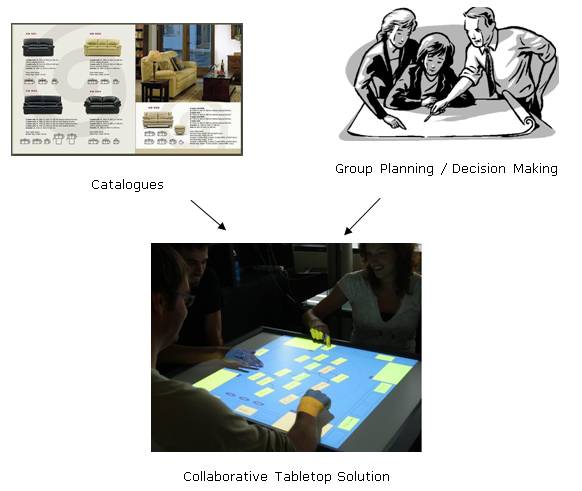Design team members: Tianyang Chang, Arthur Chow, Gartheepan Rasaratnam
Supervisor: Prof. Stacey D. Scott
Background
In current retail environments, most retailers invite customers to their stores, evaluate their inventories and then make a purchase. This traditional method of sales enables customers to physically see and feel the products prior to purchase. However, this existing way of retailing has its drawbacks. First, it is expensive for the shop owners to physically display all their inventories to the customers. Second, customers lack a direct understanding of the product’s spatial specifications relative to the area in which they intend to use the product.
Some retail shops, such as furniture chains, have come up with digital solutions to such problems. However, the current solutions of an online catalogue with static images are far from satisfying to the customers. They are typically not designed to be user-friendly, or do not have enough functions to support customers’ requirements, such as the ability to spatially map the purchased object to their space.
Motivation:
In
many
retail
based
decision-making
problems,
there
is
a
need
for
people
to
consider
the
opinions
of
others
(family,
agent,
etc.)
while
making
a
decision.
Whether
the
task
is
finding
the
right
colour
paint
for
the
living
room,
or
finding
a
house,
or
even
choosing
which
digital
images
to
print,
people
value
other
people’s
opinions.
There
are
current
solutions
for
meeting
some
of
these
needs;
however
these
approaches
do
not
sufficiently
take
into
account
the
need
for
collaboration.
Problem
Statement:
Customers
have
a
difficult
time
making
decisions
on
purchases
when
spatial
specifications
of
the
products
are
of
center
importance
of
the
decisions.
This
is,
because
current
solutions
for
spatial
visualization
and
group
decision
making
provided
by
the
retailers
are
neither
intuitive
nor
convenient.
Meanwhile,
the
current
solutions
are
also
expensive
for
retailers
to
display
their
entire
inventory
to
customers.
Recent
developments
of
digital
tabletop
computers
that
allow
users
to
interact
with
computers
using
touch
gestures,
and
the
increased
adoption
of
cellular
phone
technology
present
an
opportunity
to
make
shopping
a
more
pleasant
experience
for
customers,
while
reducing
expenses
for
the
shop
owners
at
the
same
time.

Project description
The
final
product
of
this
design
project
will
be
dedicated
to
benefit
both
store
owners
and
customers:
for
the
store
owners,
the
design
will
make
a
major
cut
to
their
expenses
by
reducing
the
needs
of
physically
displaying
their
entire
inventories;
for
the
customers,
this
new
device
will
improve
the
shopping
experience
by
providing
them
a
better
group
decision
making
tool
and
allow
for
a
better
perceptive
of
the
products
being
purchased.
To
deliver
this
result,
the
concept
of
surface
computing
is
employed.
As
an
important
function
of
the
group
thinking
tools,
the
final
design
should
be
able
to
handle
multi-touch
simultaneously
from
multiple
users.
The
product
should
have
the
ability
to
differentiate
touches
of
one
user
from
those
of
another,
possibly
through
user-tracking
implemented
with
vision
image
processing
(VIP).
The
design
group
will
work
closely
with
another
team
on
this
matter
and
rely
entirely
on
their
engineering
proficiencies
to
deliver
the
function.
Design methodology
-
Identify
the
user
interaction
requirements
for
a
retail
tabletop
application
-
Conduct
a
literature
review
of
existing
research
in
multiple
user
interaction
with
tabletop
displays
in
retail
environments.
During
the
design
process,
the
development
will
involve
users
and
other
stakeholders
and
obtain
feedback
and
suggestions
in
the
development
process.
- Conduct a usability test and observe behaviour of multiple users in the prototype application and utilize the findings to further improve the prototype.
-
Conduct
a
literature
review
of
existing
research
in
multiple
user
interaction
with
tabletop
displays
in
retail
environments.
During
the
design
process,
the
development
will
involve
users
and
other
stakeholders
and
obtain
feedback
and
suggestions
in
the
development
process.
-
Identify
the
user-specific
data
that
would
be
necessary
in
the
retail
environment
application
-
Determine
what
information
would
be
useful
to
the
user
through
interviews
and
surveys.
-
Investigate
aggregated
usage
data
that
may
be
of
interest
to
retailers,
such
as
preferences
as
users
create
their
ideal
rooms.
- Attempt to integrate user-specific data with helpful User Interface (UI) elements to provide furniture recommendations based on user preferences inferred based on their prior selection of colour schemes and furniture styles.
-
Determine
what
information
would
be
useful
to
the
user
through
interviews
and
surveys.
-
Design
an
interactive
prototype
for
a
multi-touch
tabletop
computing
system
-
Develop
easy-to-use
and
inviting
display
elements
to
support
an
effective
and
elegant
user
interaction.
-
Three
major
iterations
of
the
prototype
will
be
created:
a
low-fidelity,
medium-fidelity,
and
high-fidelity
prototype.
-
Prototypes
will
be
used
to
gather
additional
user
feedback
for
improvement
in
the
next
iteration.
-
The
low-fidelity
prototype
is
used
to
explore
the
design
and
allow
for
quick
modification.
-
The
medium-fidelity
prototype
will
present
a
more
refined
version
approaching
the
final
design.
- The high-fidelity interactive prototype will be very similar to the final design and will be enhanced with individualized user tracking with an user identification module provided by the VIP group.
-
The
low-fidelity
prototype
is
used
to
explore
the
design
and
allow
for
quick
modification.
-
Develop
easy-to-use
and
inviting
display
elements
to
support
an
effective
and
elegant
user
interaction.